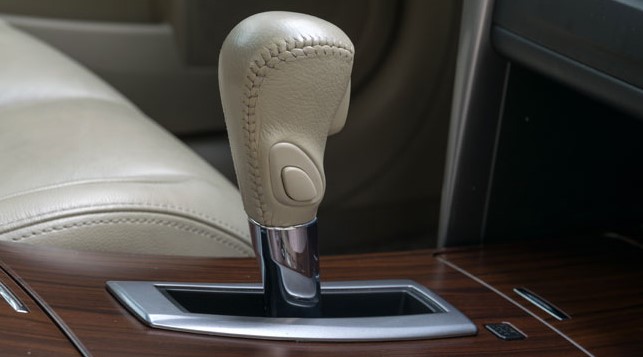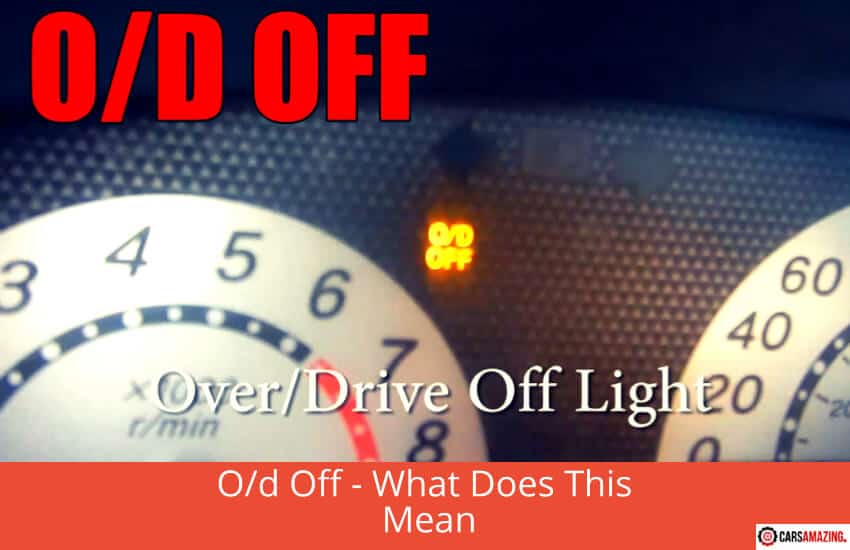Last Updated on December 29, 2022 by Leepu Da Maxim
O/d Off means “overdrive off” and it refers to the overdrive functionality of a transmission. This is a very common feature that you will mostly see in automatic transmission vehicles. The O/d Off function allows you to get high performance in an automatic car, as well as the highest transmission gear.
Key Takeaways
- The O/D Off feature can improve fuel efficiency and reduce wear on the engine
- When the O/D Off feature is activated, it disables the overdrive function so the vehicle will operate in a lower gear at all times
- The O/D Off feature will be very helpful while driving up a steep hill or when towing a heavy load
- You can activate the O/D Off by pressing a button on the dashboard or using a control on the gear shift lever
Key Considerations For Using Overdrive Efficiently
| Tip | Description |
| Indicator blinking | Whenever the overdrive indicator is blinking, you need to turn off this function. This is a sign of some vehicle failure. |
| Traveling In A Low Gear | When you need to travel at a low speed, it is not recommended to use an overdrive. This will simply give bad results. |
| Use Overdrive To Overtake | When you are traveling at a high speed, you can turn this function off. This way, your vehicle will slow down by one gear and you will have additional acceleration. |
| Pros | Excellent fuel economy better engine care Less pollution to the environment reduced engine-generated noise |
| Cons | This feature increases the cost of vehicle repairs to overdrive vehicles are also more expensive |
Is O/D Supposed To Be On Or Off?

Usually, the od function can decrease the wear and tear on the vehicle. It is mostly used for people who need to travel at highway speed and save some fuel.
The vehicle’s performance also decreases considerably. Conversely, it may be necessary to turn this feature off if you are in a mountainous area with an uneven surface. So, here this type of function will not be able to provide an advantage to overcome this surface.
On the contrary, it is an excellent idea to activate this function if you are on a flat surface such as a road. Here, you will have the possibility to save gas while maintaining an excellent performance along the whole road.
That’s why it’s one of the best functions or features a vehicle can have for a long journey. Of course, it is necessary to use this function properly to avoid malfunctions.
Can Overdrive Mess Up Transmission?
Here, it is necessary to consider that this function allows us to obtain excellent savings on fuel throughout a trip. The wear and tear on the engine and the various components of the vehicles are also reduced.
Therefore, if you want to obtain a longer life for the vehicle, it is advisable to use this function from time to time. To obtain a good result, the torque demand should not be too high. On the contrary, when you need high torque, then this function can harm the performance of your vehicle.
It could even happen that an engine suffers some serious failure or simply that an engine dies. For this, the user should accelerate and increase the torque demand. By doing this, the operation goes directly against the way the overdrive function works.
The clutch and transmission could be damaged if the torque is too high during deceleration. By taking each of these aspects into account, the driver has the possibility of avoiding a great deal of damage. These errors will require a considerable budget to repair all damaged areas of the vehicle.
How Fast Can You Go With Overdrive Off?
In principle, it is necessary to activate this function when your vehicle goes up at a certain speed during the trip. Therefore, if this function is turned off then there are no limits to the automatic transmission of a car. This only has limits in the lower gears.
To use the od function, the vehicle must exceed 70 kilometers per hour. In other words, a vehicle should exceed 40 or 45 miles per second. As mentioned, it is also necessary to use this function under certain specific conditions.
On the one hand, it is necessary to exceed this speed to avoid a malfunction in your car. However, also the torque demand should not be too high. Here, simply the various components of the vehicle will work at too intense a level.
So, this will only succeed in wearing down the most vulnerable parts of the vehicle much faster. Here the most likely result will be a transmission or clutch failure. So, if you use the overdrive function exactly, you will have the possibility to take care of the engine performance, and save an excellent amount of fuel during the trip.
Does Turning Off Overdrive Make Your Car Faster?
The moment a driver decides to turn off this function, then the engine braking works more effectively. The vehicle shifts down a gear, allowing acceleration from there. So, this type of functionality is designed to be able to take care of the life of the engine and the various components of the vehicle.
Besides, the vehicle’s fuel utilization is also optimized to a great extent. Therefore, by using this function, then the vehicle can go at a high speed without requiring high torque demand.
On the other hand, when the torque demand is very considerable, then it is not recommended to use this function. Here the operation of the vehicle and the overdrive function go exactly opposite ways. On the one hand, the function prevents the vehicle from running at maximum performance when high torque is required.
This is why when this demand increases at certain times, then some components become stressed and start to fail. Generally, the first failures occur in the clutch and transmission of any vehicle. So, it is best to use this feature when you are traveling on a road.
When Should I Turn Off Overdrive?

First, it is recommended that you turn off the od function when you are traveling at a speed of fewer than 70 kilometers per hour. In the same way, you should use this function if your vehicle is only traveling at a speed greater than 40 miles per hour.
When a vehicle is traveling at a low speed, it requires a stop to overcome inertia and move forward. If this function is on, then the vehicle cannot rely on all the power it needs. It could be even more detrimental to use this function at low speeds, than not to use it at all.
Second, it is also highly recommended to turn this function off when you are not driving on a road. So, when your vehicle is on an uneven surface, the torque demand increases considerably.
Here, the vehicle simply needs more force to move forward and overcome various obstacles. Of course, when you are traveling on a road, the torque demand is not too high. In other words, it is best to maintain a constant, high speed on a road to use an overdrive.
Should I Drive In Overdrive All The Time?
It is usually not a bad idea to use this feature to drive for a long distance on your trip. However, some conditions need to be met if you think you can avoid the various types of damage that can occur to your vehicle.
When you turn this function off, then you do not get fuel economy and more noise is produced at high speeds. Here, this means that the vehicle can withstand increased torque demand. So, you can travel in different situations with this function off if you prefer.
On the other hand, as mentioned above you can travel with this function as long as you have exceeded 70 kilometers per hour. Otherwise, the vehicle will not have the necessary power and some components of the vehicle may become too worn out.
Also, it is always necessary to consider the road you will have to travel on with your vehicle. When you need to drive on steep hills or uneven roads it is not recommended to turn on this function.
When you only need to travel on the road, you can use this feature if you are traveling at high speed. Here, the fuel economy will allow you to save some money on the trip.
What Happens If Your Overdrive Goes Out?
In principle, the only significant effect when this function is turned off is that the vehicle shifts down one gear in the transmission. In turn, fuel economy will no longer be present and normal operation will return. However, there is no major inconvenience when your vehicle no longer has this function.
Besides, it is also necessary to turn this feature off if you are traveling at a low speed or on uneven surfaces. Here, your vehicle is left much faster and the service life is reduced considerably.
Does Having Overdrive Off Save Gas?
You can save fuel if you are traveling at more than 45 miles per hour and turn on the overdrive feature. Turning this feature off does not save fuel at all.
Of course, to use this feature, you must be on a road and not on an uneven surface. Also, this feature can preserve the life of the engine and other related vehicle components.
References:
https://www.ifixit.com/Answers/View/210295/What+is+O-D+off+on+dash+board
https://www.ifixit.com/Answers/View/210295/What+is+O-D+off+on+dash+board

Hi, I’m Leepu Da Maxim, a dedicated car enthusiast with over 10 years of experience in this field, and I’m thrilled to share my passion and expertise with fellow car enthusiasts like you. My journey began in my hometown West Jordan, Utah, where my fascination with the mechanics and design of cars sparked at a young age. Over the years, this passion has evolved into a commitment to providing accurate, insightful, and engaging information about all things automotive through CarsAmazing.
